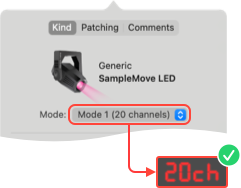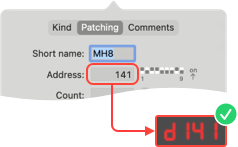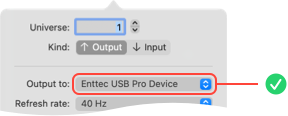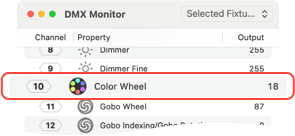Can’t find the right answer?
Write us a message and we’ll get back to you as soon as possible.
Here’s a collection of helpful tips:
First of all, check if your interface is on the list of supported interfaces. Other interfaces may not work with Lightkey.
Go to the DMX Output pane of Lightkey’s Settings (or Preferences) window and make sure the correct output option for your interface is enabled. The first three options are mutually exclusive, so only one of them can be enabled at any time.
| To use this DMX interface… | …enable this option |
|---|---|
| Enttec Open DMX USB | Open DMX Interfaces |
| Eurolite USB-DMX512 | Open DMX Interfaces |
| Eurolite USB-DMX512-PRO Cable | Eurolite PRO |
| Eurolite USB-DMX512-PRO MK2 | Eurolite PRO |
| Any other USB interface | Serial USB Interfaces |
If a wrong option was initially enabled, macOS may have associated your interface with the wrong device driver. In this case it helps to unplug the DMX interface and replug it after about one minute. If this doesn’t help then you should restart your Mac.
There may be conflicts if other applications try to access your DMX interface. Please quit all other lighting control applications, then choose Lightkey > Reset DMX Output from the menu bar. If your interface still doesn’t appear, restart your computer and then open Lightkey again.
Lightkey can find most Art-Net nodes automatically. Follow these steps:

Once Lightkey knows which node to send Art-Net data to, you also need to patch the universe(s) to Art-Net:
![]()
Connect the Art-Net interface directly to the Mac with an Ethernet cable. There should be no router between the computer and the Art-Net interface. It may help to disable other network interfaces in the Network pane of System Settings.
Assign your computer a static IP address. The is done in the Network pane of System Settings. If the Art-Net node is directly connected to the computer, DHCP is not being used.
You can find more information about choosing the IP address in the node’s documentation. Some Art-Net nodes require the address to begin with “2” or “10”, for example. The computer’s IP address must be different from that of the Art-Net node, and the computer must be on the same IP subnet as the node.
Starting with macOS 15, Lightkey requires permission to connect to Art-Net interfaces. Make sure that you allow access to devices on local networks, as explained here.
Even if you have granted permission, it may help to disable and re-enable the setting in System Settings.
Check with the manufacturer if a firmware update is available for your interface.
Reset your interface to factory settings (see device documentation).
Art-Net universe numbers start at 0. However, some Art-Net interfaces (e.g. DMXking eDMX) display universe numbers which start at 1 and are therefore offset by one from those in Lightkey. In this case you must add 1 to Lighkey’s universe numbers when you configure your Art-Net node.
Here’s a screenshot from the eDMX Configuration utility:

(A) 1-based universe number. (B) 0-based universe number; this must match the Art-Net universe number in Lightkey.
If you see no response from some or all of your lights there are many possible causes. The following steps should help you track down the problem.
Do the DMX addresses and modes match? The first step should be to ensure the DMX addresses assigned to your fixtures match the addresses in Lightkey. If your fixtures have multiple operation modes, the mode must match as well.


Is Lightkey sending DMX to the fixtures? Choose Window > DMX Monitor (or DMX Output) from the menu bar to see Lightkey’s DMX output. At least some of the channels occupied by your fixtures should show non-zero values.
![]()
Is the universe patched to a DMX interface or network protocol? Choose Lightkey > Manage Fixtures… from the menu bar, then double-click a universe near the top:

Art-Net: Can Lightkey find your node? When using Art-Net, verify that Lightkey is (still) able to find your node, as described here.
Art-Net or sACN: Does the universe match? When using Art-Net or sACN, the node must be set to the same universe number as Lightkey. See your node’s documentation on how to change the universe.

Note that some Art-Net nodes (e.g. DMXking eDMX) display universe numbers which are offset by one from Lightkey’s.
If your fixtures still don’t respond: The next step is to look for errors on the hardware or electrical level. Possible causes include faulty or unsuitable DMX cables, a single faulty fixture in the DMX chain, or a defective DMX interface.
Check the following points if you try to turn a fixture on but all of its channels show zero values in the DMX Monitor.
![]()
Is your Lightkey license active? To see the state of your license, choose Lightkey > About Lightkey from the menu bar.
Is the fixture within the active channels? The number of active output channels depends on your license. Fixtures outside the active channels appear gray in the Fixture Manager.
Has DMX output to the fixture been disabled? See “Disable fixtures” in chapter 13, “Manage DMX fixtures”, of the Lightkey User Guide.
This guide helps you if your lights generally react to commands from Lightkey but their behavior isn’t as expected. For example: A fixture is constantly strobing, shows wrong colors, or spins permanently. Follow the steps from top to bottom to track down the issue.
Is the unwanted behavior also visible in the Preview? This question helps you distinguish between problems in the project or elsewhere.
If yes: A fixture’s behavior is determined by active cues and presets, overridden fixture properties, and default property values. It often helps to review the active cues and the fixture properties they define. If you can’t track down the problem, send us a message with your project file and the steps required to reproduce the problem.
In this case you can ignore the following steps.
If not: Proceed to the next step.
Do the DMX addresses and modes match? Make sure the DMX addresses assigned to the fixtures match the addresses in Lightkey. If your fixtures have multiple operation modes, the mode must match as well.


Which fixture profile are you using? If a fixture’s behavior differs from the Preview, the cause is often found in the fixture profile.
If you’re using a profile from the built-in library or our online fixture library: Verify that the fixture name exactly matches your fixture. Profiles for a slightly different fixture model often won’t work.
If you’re using a profile from a different source: We recommend that you use our free fixture profile service to get a verified, professionally created profile.
Verify Lightkey’s DMX output to the fixture. Select a fixture in the Preview and choose Fixture > Show DMX Output from the menu bar. Then check if the DMX output matches the expected fixture state by comparing the channels and their values to the DMX chart in the fixture manual.
How to verify the DMX output to a fixture
If you think the DMX output is wrong: If the fixture profile is from the built-in library, send us a message and tell us which channel(s) is/are incorrect, what the channel values are and which values you expected instead. It may help to include the DMX chart because sometimes there are multiple DMX chart revisions for the same fixture.
If the DMX output matches the DMX chart but the fixture still shows a different behavior: In this case either the DMX chart is wrong or the fixture isn’t working correctly. We recommend that you contact the fixture manufacturer for assistance. For example, an updated or corrected version of the DMX chart may be available.
If a fixture’s behavior doesn’t match what you see in the Preview, verifying Lightkey’s DMX output often helps to track down the problem. To see the DMX output to the fixture, select a single fixture in the Preview and choose Fixture > Show DMX Output from the menu bar.
For example, here’s how to proceed if a fixture has the wrong color:
Select a color in the Design view and observe which channel changes its output value.

Compare the channel number and value to the DMX chart in the fixture manual. Is this the correct channel for controlling the color? Does the value match the color you selected in the Design view?

Here, channel 10 controls the color wheel, and the value 18 is within the range of the selected color, so the output is correct.
It’s advisable to also look at other channels which might affect the fixture’s behavior. For example, if a fixture has multiple color wheels you should check their channels as well.
Write us a message and we’ll get back to you as soon as possible.